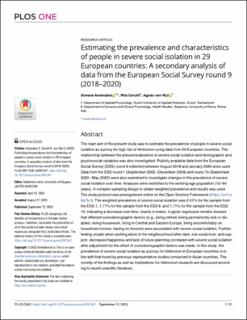Please use this identifier to cite or link to this item:
https://doi.org/10.21256/zhaw-29242Full metadata record
| DC Field | Value | Language |
|---|---|---|
| dc.contributor.author | Amendola, Simone | - |
| dc.contributor.author | Cerutti, Rita | - |
| dc.contributor.author | von Wyl, Agnes | - |
| dc.date.accessioned | 2023-12-01T14:01:03Z | - |
| dc.date.available | 2023-12-01T14:01:03Z | - |
| dc.date.issued | 2023-09-12 | - |
| dc.identifier.issn | 1932-6203 | de_CH |
| dc.identifier.uri | https://digitalcollection.zhaw.ch/handle/11475/29242 | - |
| dc.description.abstract | The main aim of the present study was to estimate the prevalence of people in severe social isolation as a proxy for high risk of hikikomori using data from 29 European countries. The relationship between the presence/absence of severe social isolation and demographic and psychosocial variables was also investigated. Publicly available data from the European Social Survey (ESS) round 9 collected between August 2018 and January 2020 were used. Data from the ESS round 1 (September 2002 –December 2003) and round 10 (September 2020 –May 2022) were also examined to investigate changes in the prevalence of severe social isolation over time. Analyses were restricted to the working-age population (15–64 years). A complex sampling design to obtain weighted prevalence and results was used. The study protocol was preregistered online on the Open Science Framework (https://osf.io/6a7br/). The weighted prevalence of severe social isolation was 2.01% for the sample from the ESS 1, 1.77% for the sample from the ESS 9, and 1.71% for the sample from the ESS 10, indicating a decrease over time, mainly in males. Logistic regression models showed that different sociodemographic factors (e.g., being retired, being permanently sick or disabled, doing housework, living in Central and Eastern Europe, living uncomfortably on household income, having no income) were associated with severe social isolation. Further, feeling unsafe when walking alone in the neighbourhood after dark, low social trust, and support, decreased happiness and lack of future planning correlated with severe social isolation after adjustment for the effect of sociodemographic factors was made. In this study, the prevalence of severe social isolation as a proxy for hikikomori in European countries is in line with that found by previous representative studies conducted in Asian countries. The novelty of the findings as well as implications for hikikomori research are discussed according to recent scientific literature. | de_CH |
| dc.language.iso | en | de_CH |
| dc.publisher | Public Library of Science | de_CH |
| dc.relation.ispartof | PLOS ONE | de_CH |
| dc.rights | https://creativecommons.org/licenses/by/4.0/ | de_CH |
| dc.subject | Europe | de_CH |
| dc.subject | Emotion | de_CH |
| dc.subject | Medical risk factor | de_CH |
| dc.subject | Social anxiety disorder | de_CH |
| dc.subject | Happiness | de_CH |
| dc.subject | Mental health | de_CH |
| dc.subject | Psychiatry | de_CH |
| dc.subject | Personality disorder | de_CH |
| dc.subject | Salary | de_CH |
| dc.subject.ddc | 616.89: Psychische Störungen, klinische Psychologie und Psychiatrie | de_CH |
| dc.title | Estimating the prevalence and characteristics of people in severe social isolation in 29 European countries : a secondary analysis of data from the European Social Survey round 9 (2018–2020) | de_CH |
| dc.type | Beitrag in wissenschaftlicher Zeitschrift | de_CH |
| dcterms.type | Text | de_CH |
| zhaw.departement | Angewandte Psychologie | de_CH |
| zhaw.organisationalunit | Psychologisches Institut (PI) | de_CH |
| dc.identifier.doi | 10.1371/journal.pone.0291341 | de_CH |
| dc.identifier.doi | 10.21256/zhaw-29242 | - |
| zhaw.funding.eu | No | de_CH |
| zhaw.issue | 9 | de_CH |
| zhaw.originated.zhaw | Yes | de_CH |
| zhaw.pages.start | e0291341 | de_CH |
| zhaw.publication.status | publishedVersion | de_CH |
| zhaw.volume | 18 | de_CH |
| zhaw.publication.review | Peer review (Publikation) | de_CH |
| zhaw.webfeed | Klinische Psychologie | de_CH |
| zhaw.author.additional | No | de_CH |
| zhaw.display.portrait | Yes | de_CH |
| Appears in collections: | Publikationen Angewandte Psychologie | |
Files in This Item:
| File | Description | Size | Format | |
|---|---|---|---|---|
| 2023_Amendola-etal_Estimating-prevalence-people-severe-social-isolation_PONE.pdf | 692.42 kB | Adobe PDF |  View/Open |
Show simple item record
Amendola, S., Cerutti, R., & von Wyl, A. (2023). Estimating the prevalence and characteristics of people in severe social isolation in 29 European countries : a secondary analysis of data from the European Social Survey round 9 (2018–2020). Plos One, 18(9), e0291341. https://doi.org/10.1371/journal.pone.0291341
Amendola, S., Cerutti, R. and von Wyl, A. (2023) ‘Estimating the prevalence and characteristics of people in severe social isolation in 29 European countries : a secondary analysis of data from the European Social Survey round 9 (2018–2020)’, PLOS ONE, 18(9), p. e0291341. Available at: https://doi.org/10.1371/journal.pone.0291341.
S. Amendola, R. Cerutti, and A. von Wyl, “Estimating the prevalence and characteristics of people in severe social isolation in 29 European countries : a secondary analysis of data from the European Social Survey round 9 (2018–2020),” PLOS ONE, vol. 18, no. 9, p. e0291341, Sep. 2023, doi: 10.1371/journal.pone.0291341.
AMENDOLA, Simone, Rita CERUTTI und Agnes VON WYL, 2023. Estimating the prevalence and characteristics of people in severe social isolation in 29 European countries : a secondary analysis of data from the European Social Survey round 9 (2018–2020). PLOS ONE. 12 September 2023. Bd. 18, Nr. 9, S. e0291341. DOI 10.1371/journal.pone.0291341
Amendola, Simone, Rita Cerutti, and Agnes von Wyl. 2023. “Estimating the Prevalence and Characteristics of People in Severe Social Isolation in 29 European Countries : A Secondary Analysis of Data from the European Social Survey Round 9 (2018–2020).” Plos One 18 (9): e0291341. https://doi.org/10.1371/journal.pone.0291341.
Amendola, Simone, et al. “Estimating the Prevalence and Characteristics of People in Severe Social Isolation in 29 European Countries : A Secondary Analysis of Data from the European Social Survey Round 9 (2018–2020).” Plos One, vol. 18, no. 9, Sept. 2023, p. e0291341, https://doi.org/10.1371/journal.pone.0291341.
Items in DSpace are protected by copyright, with all rights reserved, unless otherwise indicated.